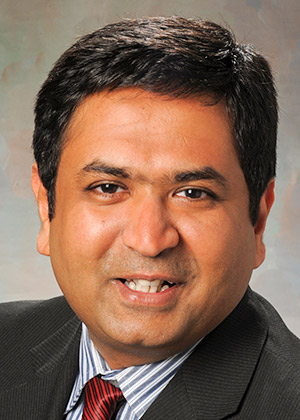Ready to leave 2020 behind? Here’s what UA experts predict for 2021
12/18/2020After a year like no other in our collective memory — with an ongoing pandemic, widespread protests of racial injustice and inequities, and a contentious presidential election, just for starters, we’re ready to close the door on 2020.
We’ve got high hopes for 2021.
Will new vaccines protect us from COVID-19? Can President-elect Joe Biden deliver on campaign promises? In the new year ahead, can we really begin to heal what divides us?
We asked several of our University of Akron experts to offer predictions for how 2021 could unfold.
POLITICAL SCIENCE
Prediction: Nothing will come easy for our 46th president.
By Dr. David Cohen, professor of political science and interim director of UA’s Ray C. Bliss Institute of Applied Science

Dr. David Cohen
Our country is more divided than at any time in my lifetime, even as the nation grapples with COVID-19, the most serious public health crisis in 100 years — perhaps American history. Normally during a crisis, the American people come together, if only for a brief time, and rally around the flag. Not in 2020, and certainly not in 2021. Though Joe Biden defeated Donald Trump in convincing fashion — seven million-plus popular votes and 74 electoral votes (306-232) — Trump has spent the transition period undermining the American constitutional system by refusing to concede, delaying the transition, publicly claiming the election results were fraudulent, and filing multiple lawsuits in order to overturn the election results in several states. This has undermined the American people’s confidence in the presidential election outcome, especially among a strong majority of Republicans. These actions by a sitting POTUS are unprecedented in American history; when President Trump is forced to leave office on Jan. 20, he will assuredly continue to fan the flames of division through his Twitter account and campaign-style events.
Going forward, these actions by the former president will make it much more difficult for President Biden to bring not only the American people together, but to work with both political parties in Congress. Besides COVID-19, the United States faces major challenges that will need bipartisan solutions — a steep economic recession that has caused record unemployment and business closures, rising health care costs and millions of Americans who are uninsured or underinsured, climate change and the resulting natural disasters it causes, and long unaddressed issues of social injustice and inequality. President Biden’s attempts to bring the American public and political parties together to address these critical issues — though well-intentioned — will be a quixotic quest that ultimately ends in failure.
COVID-19
Prediction: With wide availability of vaccines, we could reach herd immunity against COVID-19 by the summer.
By Dr. Hazel A. Barton, professor of biology and director of the Integrated Bioscience Program

Dr. Hazel A. Barton
The COVID-19 pandemic has been one of society’s biggest shocks, with disruptive effects on par with 9/11 or WWII. Just as those events changed our culture in ways we would never have predicted, the same will be true for COVID; however, some of these initial changes will become apparent in 2021, greatest of which will be vaccines.
The Pfizer and Moderna vaccines were the first vaccines against SARS-CoV-2, due to the simplicity in their manufacture. Rather than inactivated or subunit vaccines (think of measles or the flu) manufactured from the virus itself, these RNA vaccines just needed to include a small piece of genetic material that our bodies could use to cause antibody protection and immunity. But these RNA fragments are fragile, complicated to make, and must be protected by an envelope that requires special handling and very cold temperatures. As a result, these initial vaccines will be limited in availability, and only the most critical workers and vulnerable adults will be able to receive it. But as 2021 progresses, more of the traditional-type vaccines will also become available, and the rate at which the rest of us can be vaccinated will continue to accelerate worldwide. I predict that we will start to reach herd immunity against COVID-19 by the summer, when we can start interacting and attend large, public events.
There will also be dramatic confrontations about the value of vaccines and vaccine safety, and I hope that these conversations will clearly identify the Anit-Vaxx movement as nothing but a dangerous ideology with no basis in science.
The impacts that COVID-19 has had on our society will also be more obvious in 2021. We are more likely to become a mask-wearing society, and you can expect to see people wearing masks when traveling and grocery shopping for many years to come. Proof of vaccination and vaccine passports may also be needed to return to work, school or travel overseas.
SARS-CoV-2 is the fourth novel coronavirus that has emerged since 2003. It is my very real hope that in 2021 we find the political will needed to fund infectious disease research to identify similar threats, prepare the global-scale containment and identification procedures needed to contain future pandemics, and finally address the human impacts on our ecosystem that are accelerating the spill of such dangerous viruses into the human population.
BUSINESS
Prediction: 2021 will see cross-industry and public-private partnerships to ramp up and reconfigure cold-chain supply chains to meet the vaccination challenge.
By Dr. Mahesh Srinivasan, associate professor of management and director of the Institute for Global Business

Dr. Mahesh Srinivasan
As we enter into 2021, citizens and governments all across the world are starting to heave a sigh of relief because the end to the COVID-19 pandemic seems within sight. Kudos to the professionals in the medical and scientific field who have worked tirelessly in developing the vaccines for COVID-19. Now the pharmaceutical industry and their allied logistical service providers must configure their supply chains to facilitate rapid distribution of these vaccines across the world. The major challenge here is to maintain the temperature integrity of the vaccines through the supply chains.
There are many vaccine candidates, each having their requirements. For example, the Pfizer vaccine seems to require the most demanding cold-chain requirements to store the vaccines at minus 70 degrees Celsius or below, but also promises to be one of the most effective. It is going to be a challenge to design cold-chain storage and delivery systems for the billions of doses scheduled to be administered worldwide. Expect significant continued investments in cold-chain facilities through cross-industry collaborations (for example major logistical providers like FedEx, DHL and UPS working with pharmaceutical companies) and public-private partnerships (including government funding at federal, state and local levels) to meet this challenge.
However, this has also resulted in increased vulnerability for these cold chains. We are already seeing actors trying to take advantage of the situation with, for example, increased phishing attacks. My prediction is that the industry will rise up to the challenges, navigate a few hiccups along the way to build an eco-system that will deliver the vaccines where needed and give us valuable lessons that will prepare us for the next pandemic. The physical and economic health of people across the globe is dependent on it.
THE ARTS
Prediction: Theatres won’t stay dark — look for live performances by fall.
By Dr. Marc Reed, director of the School of Music and the School of Dance, Theatre and Arts Administration

Dr. Marc Reed
The arts will bounce back in a big way as 2021 progresses. Everyone has been impacted by COVID-19, but the arts, because of their collaborative nature, have been extremely damaged. Broadway shows, touring productions, major symphony orchestras and virtually every other live performance has been either cancelled or relegated to presenting only virtual performances. In short, the arts are hurting.
However, I’m confident that once vaccination efforts become widespread and the virus begins to wane, the arts will return in a way that we have seldom seen. A tremendous amount of new work is being composed, written and scored during this lull in live performances. We will likely look back on 2020 and early 2021 as a gestation period that produced some of the most exciting new art of the 21st century. I’m targeting fall 2021 as the art world’s reintroduction to society.
To all the artists and art lovers; hang in there. Brighter days are yet to come.
RACIAL JUSTICE
Prediction: The fight against all forms of injustices and inequities in our society will strengthen in 2021.
By Dr. Sheldon Wrice, interim vice president for inclusion and equity and chief diversity officer

Dr. Sheldon Wrice
The phrase “Black Lives Matter” has become more than just a hashtag. Indeed, it has become a movement and a rallying cry for society to wake up and address racial inequity and injustices. The disturbing experiences of George Floyd, Breonna Taylor, Ahmaud Arbery and several others have pushed the discourse beyond the usual “all lives matter vs. Black lives matter” partisan mantra.
Since January 2020, nearly 175 African Americans have lost their lives under the authority of the police in this country. Each incident has come with street protests, agitations and a call to all well-meaning citizens of America, and indeed, the world over to realize that all lives can’t matter until Black lives matter. As a matter of fact, the demographic dynamics of the protesters tells a story of a society that is waking up to its ugly reality of systemic injustices.
Beyond the “Black Lives” movement and agitations is the overwhelming impact that the COVID-19 pandemic has had, and continues to have, on society. Besides the tragic deaths, measures put in place to stop the spread of the virus, such as “social distancing,” “lockdowns,” etc., have transformed the way we live, communicate and work. It has equally had emotional and psychological repercussions on many of us, particularly the vulnerable members of society.
Indeed, 2020 has been a year of challenging experience from all accounts. It is my hope and prayer that the year 2021 will prove to be a year of self-reflection, a year of support and a year of fruitful discussions on issues that affect the disadvantaged members of our society. It is my hope that the year 2021 will be different with the successful development of vaccines for COVID-19 and our collective efforts to stem the spread of the virus. It is also my hope that we will sustain the energy and maintain a common course to fight against all forms of injustices and inequities in our society.
ECONOMICS
Prediction: Economic recovery from the pandemic will be slow in Ohio, likely slower than the U.S.
By Dr. Amanda Weinstein, associate professor of economics

Dr. Amanda Weinstein
The economy in Ohio and the rest of the U.S. will continue to stall as 2021 begins and many await COVID-19 vaccinations. The speed of the economic recovery will be dependent on the speed of the vaccine production and distribution. Even after the widespread distribution of vaccines, Ohio should expect the hard work of economic recovery to continue. Ohio will likely take longer than the U.S. to recover (as it did after the Great Recession). Many of the small businesses that closed in the wake of the pandemic will not return. In Ohio, it will likely take longer for new businesses to emerge. Even before the pandemic, Ohio ranked 35th in business startup activity (as measured by the 2017 Kauffman Index).
In many ways, the pandemic further exposed the cracks that lay in the foundation of the economy of Ohio and the nation – namely, the inequitable distribution of risk and opportunity across society. Many who were pushed out of the workforce to care for sick loved ones or to care for children may struggle to rejoin the workforce. Equality in access to child care, education and health care will be essential for a productive and competitive workforce and for economic growth.
FOREIGN POLICY
Prediction: President-elect Joe Biden will recommit the U.S. to its former leadership role in the global community
By Dr. Karl Kaltenthaler, professor, director of security studies, Department of Political Science

Dr. Karl Kaltenthaler
The Biden administration faces a daunting array of challenges in foreign and security policy. A priority will be to repair relations with long-time U.S. allies that were frayed during the Trump administration. More broadly, Biden will recommit the U.S. to its former leadership role in the global community and stress the importance of multilateralism over “America First.” That will take the shape of things like putting the U.S. back into the Paris Climate Accord framework and working with other countries on issues such as COVID-19 and global economic issues. The really tough security challenges for Biden will come from China, Russia, Iran, North Korea, ISIS, and Al Qaeda. Biden will likely not re-shape U.S. policy toward China or Russia in a significantly more conciliatory direction as these countries continue to present serious challenges to U.S. national security. While Biden would like to re-enter a nuclear deal with Iran, it will not be easy going and may not happen. North Korea continues to develop missiles that can strike the U.S., and with its nuclear capabilities, this will likely become a front-burner issue for the new administration. Terrorist groups, like Al Qaeda and ISIS, have not been completely defeated and continue to grow and strengthen in some parts of the world.
WORK FROM HOME
Prediction: The remote-work revolution has begun, options will only grow in 2021.
By Dr. Erin Makarius, associate professor of management

Dr. Erin Makarius
A remote-work revolution is happening and will likely continue long after the COVID-19 crisis is resolved. Though many organizations and employees initially made the shift as a temporary necessity, working remotely has evolved into a viable paradigm for companies going forward. In a recent survey by research advisory firm Gartner Inc., 82% of executives indicated that they intend to let employees work remotely at least part time, and almost half (47%) responded they would allow employees to work remotely full time in the future. Many companies are seeing the benefits of offering that flexibility to employees and are considering offering blended options that combine remote and office work, to mitigate the challenges and enhance the advantages of remote-work environments.
For this remote-work revolution to be successful, organizations need to provide support to employees working outside the office in three main areas. First. structural support should include remote work policies, trusting climates where employees can speak up, and job characteristics that balance structure and flexibility. Second, relational support should incorporate social and task norms, informal opportunities to communicate, team building, and preservation of morale and culture. Third, cognitive support should include resources to balance work/life and help manage mental health. What’s the best option for working remotely in the future? It depends – think about the industry, job and people, and figure out what works best in each situation.
